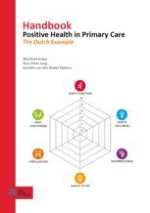Summary
This chapter focuses on the consulting room and discusses how to conduct the alternative dialogue. Positive Health first focuses on your personal experience, advising you to fill out the spider web for yourself. Once you have become an ‘experience expert’ and have achieved results with your own health, you will be more convincing in interactions with your patients. The chapter subsequently pays extensive attention to the person-oriented style of conversation, which follows on from the spider web, with examples of two possible ways of conducting the so-called alternative dialogue: asking solution-oriented questions and using the Action Wheel. The chapter looks at how to start and what questions to ask, in order to encourage patients to find solutions and take action themselves. Based on the core tasks in primary care, this chapter discusses the target groups with whom to have the alternative dialogue on the basis of the Positive Health concept. How to experience applying Positive Health in practice is described according to a number of examples, the four tools, materials, case studies, tips and pointers.
